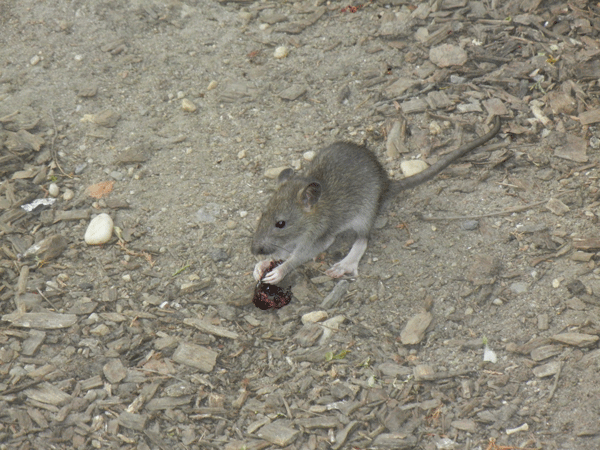
BY ALINE REYNOLDS | Though Community District 1 is ranked low on the list of Manhattan districts whose properties are infested with rats, Downtown residents are up in arms about the presence of rodents in their neighborhood.
That was the main topic of discussion at June’s Community Board 1 Quality of Life Committee meeting, where officials from the city Department of Health and Mental Hygiene spoke to the strategies the agency is undertaking to curb the rat population in Lower Manhattan.
Specifically, the D.O.H. is undertaking a new program, in which renowned city rodentologist Dr. Robert Corrigan and his team will be scrutinizing catch basins Downtown and elsewhere for rat nests and hideouts, according to Carla Toro, a research scientist for the D.O.H.
Downtown has a modest amount of green space, making the area’s parks all the more vulnerable to rat infestations, she noted.
“Rats are unfortunately looked at as a nuisance, not as a health hazard,” according to Toro’s colleague, Rick Simeone, director of the D.O.H.’s Pest Control Services.
“I wish I had a magic pellet to kill them all,” he said. “We’ll probably always have to deal with this issue…but we have found success through proactive [solutions].”
Though the D.O.H. responds to each of the thousands of rodent-related 311 complaints it receives annually, “We brought in the scientific method…because we figured that 311 wasn’t being effective enough,” explained Toro.
The new initiative follows a series of D.O.H.-led inspections of properties, both private and public, in Downtown. Over the past year, a team of inspectors identified rat-infested lots, examined the causes of the infestations and digitally recorded the data they collected.
The D.O.H.’s latest count of Downtown properties with rat sightings dropped to five percent, down from the initial inspection’s count of 11 percent, according to Toro.
If a given lot is infested with rats, the property owner will be issued a warning, she explained. If the inspector, upon a second examination, fails to see progress, the owner will be slammed with a violation.
Despite the D.O.H.’s efforts, residents in Tribeca and the South Street Seaport alike complained that they continue to see rats scurrying around the neighborhood’s streets and parks.
Paul Cantor, who lives on Lispenard Street between Broadway and Church Street, has futilely phoned the city hotline numerous times after spotting rats.
“We have four active construction sites and one empty building on the corner of Broadway, Canal and Lispenard,” he said. “When you call 311, they’re like, ‘What address?’”
Shimon Zlotnikov, a public member of C.B. 1, said he often sees rats in the vicinity of P.S. 234, at 292 Greenwich St. in Tribeca.
“The [school has] the worst sanitation habits,” he said.
An official at the elementary school, which is on summer break, wasn’t available for comment.
The nesting problem is particularly prevalent in DeLury Square, at the intersection of Fulton and Gold Streets, according to South Street Seaport residents Paul Hovitz and John Fratta.
The city Department of Parks and Recreation refused to lay down steel mesh — a rat deterrent — prior to filling out the square in preparation for its fall 2010 opening, according to Hovitz.
“It’s supposed to be a tremendous deterrent for the rats being able to gnaw through and nest…[but] they said it wasn’t cost-effective, and they didn’t do it,” he said.
Simeone said that the D.O.H. is experimenting with the technique, which requires carefully planned labor.
At one site, he explained, “we had to have 15 people from the Parks Department…dig four inches and put plywood around it. It was a tremendous amount of work, but it actually worked.”
Simeone noted that the mesh material consists of fibers that “cut up” the rat when they gnaw at it.
The D.O.H. has already begun work on area catch basins by distributing poisoned bait that, he promised, isn’t toxic to the environment.
However, Kristen Simon, who works in the cruelty investigations department of the People for the Ethical Treatment of Animals (P.E.T.A.), a national animal rights organization, cautioned that these techniques are cruel to animals and could counter the city’s overall mission of diminishing the rat population in Downtown.
Contrary to popular belief, lethal methods used toward rodents could actually cause a surge, rather than a decrease, in rats, according to Simon.
“When you remove animals from the surrounding area, more will just move in, and there will be a spike in the food supply — more food left for the ones who are behind,” she explained.
More food remnants also cause female rats to breed at an accelerated rate, Simon added, “so you end up with more rats.”
If the D.O.H. insists on killing the rodents, Simon suggested using less painful techniques than poison, such as electronic traps or even the traditional snap traps.
The New York Police Department, she noted, stopped using glue traps — which can rip rodents’ bones and flesh as they struggle to escape the traps — back in 2010.
The best way to deter rats from a given neighborhood, Simon said, is for the city to regularly pick up the trash bags that accumulate on the street.
The rats indeed feast on a buffet of garbage until the wee hours of the morning, as city sanitation workers don’t pick up the trash until around 4 a.m., according to Simeone, who noted that trash pick-up schedules aren’t in the D.O.H.’s purview.
Several other city agencies in addition to the Parks Department, including the Metropolitan Transportation Authority, have their own systems for combating the rat population, according to Simeone.
“The truth of the matter is,” he said, “we can’t go underground.”
Restaurants, however, are in the agency’s jurisdiction. Simeone said they undergo “rigorous” inspections more than once a year, and, if they’re breaking the law, they can incur penalties ranging from a lowering of their grade to a shutdown.






























